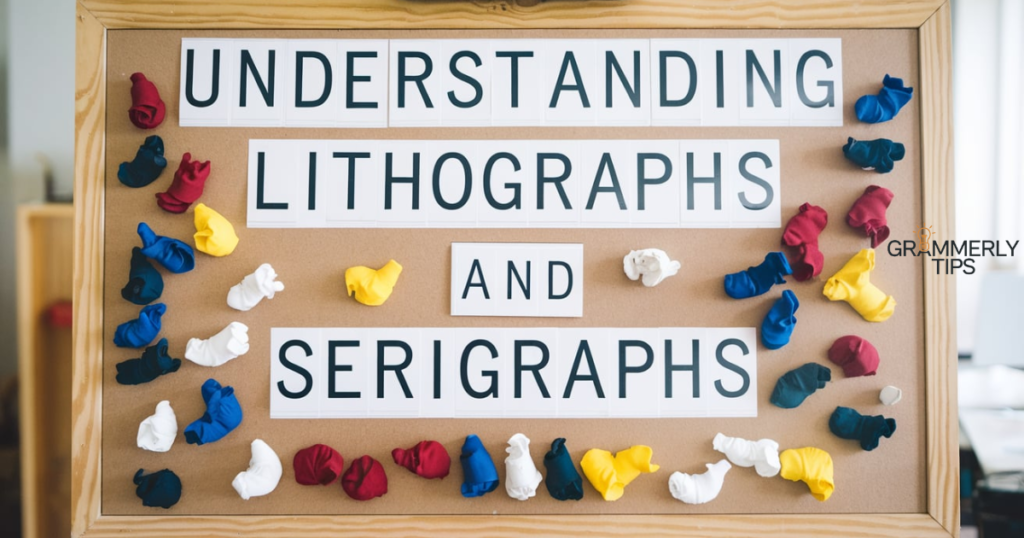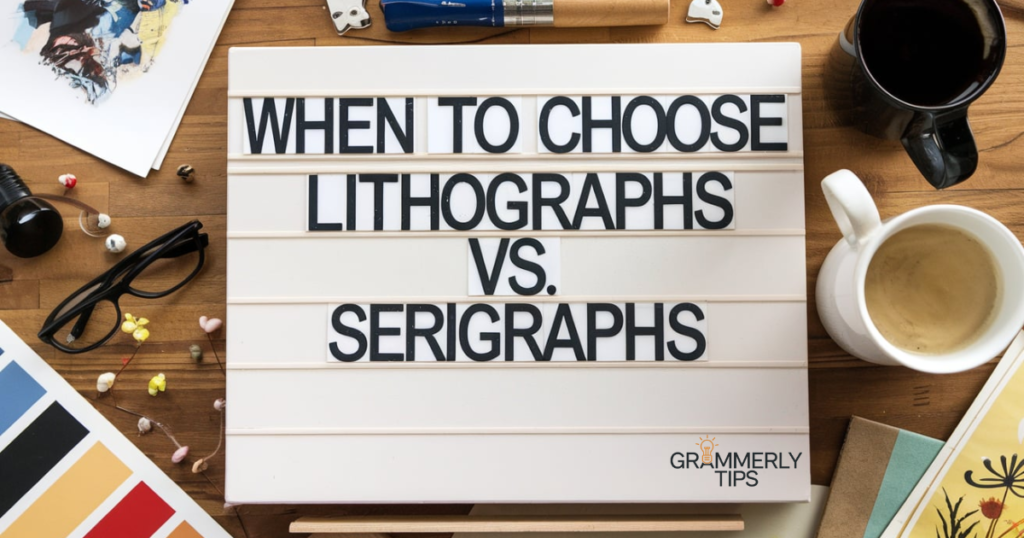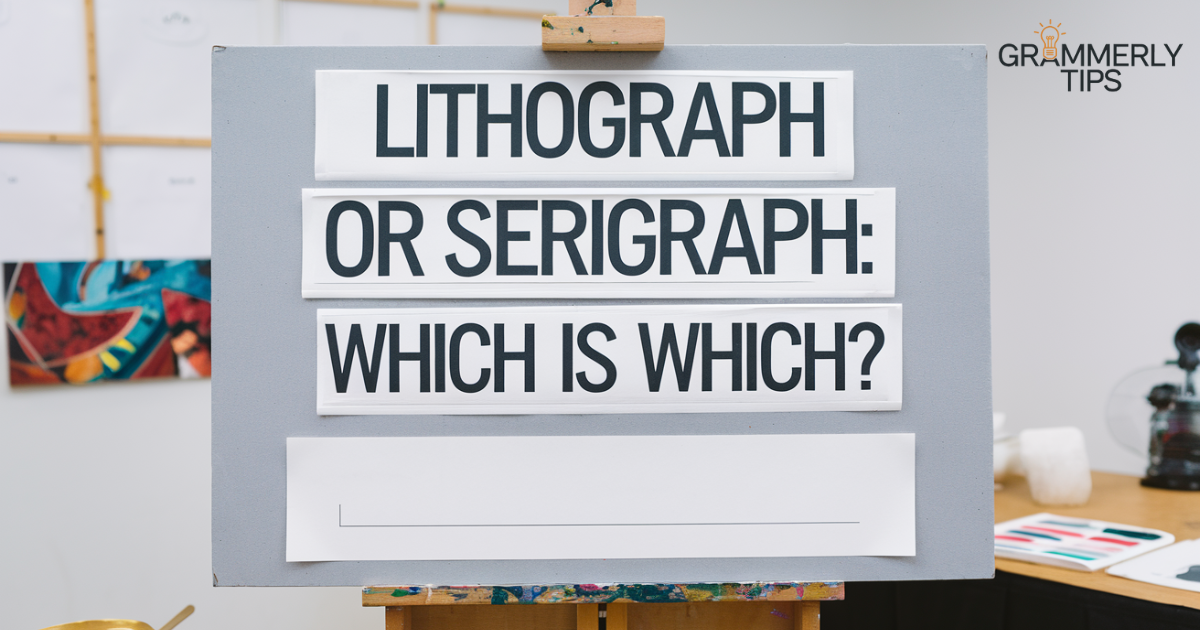When it comes to fine art prints, terms like lithograph or serigraph often come up, but many people aren’t sure about the difference between the two. Both are popular methods for producing artwork, but they use distinct techniques that affect the texture, appearance, and feel of the final piece.
Understanding whether a print is a lithograph or a serigraph can help you appreciate the artist’s process and the value of the work. Lithographs are created through a printing method that involves limestone or metal plates, while serigraphs use silk screens. Let’s dive into the differences between these two art forms.
Understanding Lithographs And Serigraphs

Lithograph: Definition and Usage
A lithograph is a type of print made using a flat stone or metal plate, where the image is drawn with an oily substance and then transferred to paper. The process involves using oil-based inks and chemical reactions to create detailed images.
Lithographs are popular for their rich textures and ability to reproduce fine details in art prints.
Examples
- The artist created a series of stunning lithographs, capturing intricate cityscapes.
- Collectors often seek rare lithographs by famous artists like Picasso.
These examples show how lithographs are used in art to reproduce detailed, high-quality prints.
You Also Like To Read This: Hale Or Hail: When Should You Use Each?
Serigraph: Definition and Usage
A serigraph, also known as a silkscreen print, is created by pressing ink through a stencil or mesh screen onto a surface, typically paper or fabric. This technique allows for vibrant colors and bold, graphic designs.
Serigraphy is commonly used for producing limited edition prints, often with multiple layers of color to achieve striking visual effects.
Examples
- The artist’s latest serigraph features a series of colorful abstract patterns.
- Andy Warhol’s famous serigraphs of celebrities are iconic in pop art.
These examples illustrate how serigraphs are used for creating vibrant, multi-colored artwork, often in the world of contemporary and pop art.
Side-by-Side Comparison of Lithograph and Serigraph
Here’s a side-by-side comparison of Lithograph and Serigraph:
| Aspect | Lithograph | Serigraph |
| Definition | A print made by drawing on a flat stone or metal plate, where the image is transferred onto paper using oil-based inks. | A print made by pushing ink through a stencil or mesh screen, often onto paper or fabric. |
| Technique | Involves drawing directly on a limestone or metal plate with greasy materials, followed by printing. | Involves using a screen (typically made of silk) to apply ink onto the surface in layers. |
| Common Usage | Often used for fine art prints, capturing detailed images with rich textures. | Common in commercial art, posters, and limited edition prints with vibrant, bold colors. |
| Materials Used | Stone or metal plates, oil-based inks, and printing press. | Mesh screen (often silk), stencil, and layers of ink. |
| Final Output | Detailed, fine-textured prints that replicate the artist’s original work. | Bold, graphic prints with a flat, layered color effect. |
| Famous Artists | Pablo Picasso, Henri Toulouse-Lautrec, and Marc Chagall. | Andy Warhol, Roy Lichtenstein, and Keith Haring. |
Key Differences
- Lithographs often focus on intricate details and textures, while serigraphs are known for their vibrant colors and graphic designs.
- Lithography uses stone or metal plates, while serigraphy utilizes a mesh screen and ink layers.
When to Choose Lithographs vs. Serigraphs

Choosing between lithographs and serigraphs depends on the style, texture, and overall aesthetic you’re looking for in a piece of art. Here’s a guide on when to choose each:
Choose Lithographs When:
- You want a print that closely replicates the fine details and textures of an artist’s original work.
- You appreciate the traditional process, as lithography is known for its intricate shading, delicate lines, and depth.
- You’re looking for high-quality, limited edition prints by famous artists, as lithographs are often associated with classical fine art.
Choose Serigraphs When:
- You prefer bold, graphic designs with vibrant colors and strong visual impact.
- You are drawn to modern or pop art styles, as serigraphy is often used by contemporary artists for its striking and colorful results.
- You’re looking for a more affordable option with an emphasis on layers of color and visual boldness.
In summary, if you seek detailed, classic art prints, lithographs are a great choice. If you want something more modern, with bold color and graphic appeal, serigraphs will suit your tastes better.
Everyday Usage Examples
Lithographs
- The gallery showcased several lithographs by famous 19th-century artists, each with incredible detail.
- I just bought a limited edition lithograph to add to my collection.
- Lithographs are often displayed in museums because they closely resemble the artist’s original work.
- The artist used a lithograph technique to create this stunning reproduction of a cityscape.
Serigraphs
- The pop-up art exhibit featured vibrant serigraphs of urban landscapes.
- She loves decorating her apartment with colorful serigraphs that brighten up the room.
- His serigraph of Marilyn Monroe is one of the most iconic pieces of modern art.
- The artist is known for his limited-edition serigraphs, each with a unique color scheme.
FAQs
How to tell if it’s a serigraph?
- Texture: Serigraphs often have a raised texture where the ink sits on top of the paper or fabric, giving it a more tactile feel.
- Vibrant Colors: Serigraphs tend to feature bold, solid colors, often in layers that create a more graphic and flat look.
- Visible Streaks: You may notice visible brushstrokes or slight variations in the ink, which come from the process of manually applying ink through the screen.
- Signature and Edition Number: Check for a signature, edition number, or “silkscreen” label, which can help confirm it’s a serigraph.
What is a lithograph vs. serigraph?
- Lithograph: A lithograph is a print made from a design drawn on a flat surface (usually a stone or metal plate), using oily materials. The process results in fine, detailed reproductions with soft gradients and rich textures.
- Serigraph: A serigraph is a print created by pushing ink through a screen (or stencil), typically onto paper or fabric. It’s known for bold, layered colors and a graphic, flat appearance.
What is a lithograph?
A lithograph is a printmaking technique where an image is created by drawing on a flat surface, typically stone or metal, with a greasy substance. The image is then transferred onto paper through a chemical process that allows ink to adhere only to the drawn parts. Lithographs are known for their detailed, textured reproductions of an artist’s original design.
What is a serigraph?
A serigraph (also known as a silkscreen print) is a print made by pushing ink through a mesh screen or stencil. This method is often used to create bold, graphic designs with layers of color. Serigraphs are commonly found in modern and pop art due to their vibrant colors and the ability to replicate bold shapes and imagery.
Conclusion
In conclusion, lithographs and serigraphs are both unique printmaking techniques that offer distinct visual results. Lithographs are known for their detailed, textured reproductions and are often used to mimic the artist’s original work.
On the other hand, serigraphs are characterized by their bold, layered colors and graphic, flat appearance, making them popular in modern and pop art. Understanding the differences between the two can help collectors and art enthusiasts appreciate the specific qualities each technique brings.

Grammerlytips.com, authored by Jame, offers expert tips and insights on mastering grammar, enhancing writing skills, and boosting communication effectiveness.

